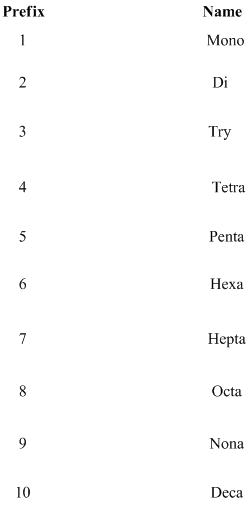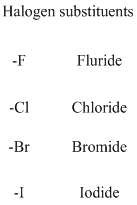
(a)
Interpretation:
The chemical formula for the given molecule should be identified.
Concept introduction:
According to the nomenclature, when two nonmetals are present in the given compound the name of the compound is given as follows, For example, HCl. According to the name of the compound, first give the name for the hydrogen followed by the second element, changing the ending of its name to –ide. Chlorine called as chloride. Therefore HCl is hydrogen chloride. Similarly, HI is hydrogen iodide. SiC is silicon carbide.
One pair of elements to form several different binary molecular compounds. In these cases, using of Greek prefixes to denote the number of atoms of each element present.
Greek prefixes are given below,

If prefix mono substituted is generally omitted for the first element. For example, SO2 is named sulfur dioxide, is not monosulfur dioxide. Moreover, only one atom in a prefix for the first element, no needs to mention mono or di etc.… In addition, for ease of pronunciation, we usually eliminate the last letter of a prefix that ends in o or a when naming an oxide. Thus, N2O5 is dinitrogen pentoxide, rather than dinitrogen pentaoxide.

If any halogens are present in the molecule in suffix, the name of the halogens as follows.

(b)
Interpretation:
The chemical formula for the given molecule should be identified.
Concept introduction:
According to the nomenclature, when two nonmetals are present in the given compound the name of the compound is given as follows, For example, HCl. According to the name of the compound, first give the name for the hydrogen followed by the second element, changing the ending of its name to –ide. Chlorine called as chloride. Therefore HCl is hydrogen chloride. Similarly, HI is hydrogen iodide. SiC is silicon carbide.
One pair of elements to form several different binary molecular compounds. In these cases, using of Greek prefixes to denote the number of atoms of each element present.
Greek prefixes are given below,

If prefix mono substituted is generally omitted for the first element. For example, SO2 is named sulfur dioxide, is not monosulfur dioxide. Moreover, only one atom in a prefix for the first element, no needs to mention mono or di etc.… In addition, for ease of pronunciation, we usually eliminate the last letter of a prefix that ends in o or a when naming an oxide. Thus, N2O5 is dinitrogen pentoxide, rather than dinitrogen pentaoxide.

If any halogens are present in the molecule in suffix, the name of the halogens as follows.

Want to see the full answer?
Check out a sample textbook solution
Chapter 5 Solutions
CHEMISTRY: ATOMS FIRST VOL 1 W/CONNECT
- Does Xenon and radon make a ionic compound, molecular compound, or neither?arrow_forwardGiven the chemical formulas MgO, Al2O3, and SiO2, predict the formula for germanium oxide, GexOy.arrow_forwardChlorate has the formula ClO3-. Therefore, the ion ClO2- is named a) Chlorite b) Chloride c) Chloric d) Perchloratearrow_forward
- Write the chemical formulas for (a) potassium sulfide, (b) calcium hydrogen carbonate c) nickel(II) perchlorate. for (d) silicon tetrabromide, (e) disulfur dichloride.arrow_forwardThe monatomic ions of Groups 1A(1) and 7A(17) are allsingly charged. In what major way do they differ? Why?arrow_forwardConsider an iodine tetrafluoride cation (IF4+): What is the elemental symbol of its central atom?arrow_forward
- A hypothetical compound with formula Xe3Ye2 is composed of the hypothetical nonmetal elements xarnium and yenium with symbols Xe and Ye, respectively. The most likely name of this compound is _____.arrow_forwardWrite the structural formulas of three different compounds that each have the molecular formula C5H12.arrow_forwardThe molecule carbon dioxide has the chemical formula CO2arrow_forward
- The chemical formula of carbon tetrachloride is CCl4. The nature of this compound is?arrow_forwardPredict the formulas of the compounds formed from the combination of ions of the following elements:a. calcium and nitrogenb. magnesium and brominec. magnesium and nitrogenarrow_forwardis the chemical formula, C2OH2N2O2, how would you write 3 molecules of this compoundarrow_forward
- Chemistry: Matter and ChangeChemistryISBN:9780078746376Author:Dinah Zike, Laurel Dingrando, Nicholas Hainen, Cheryl WistromPublisher:Glencoe/McGraw-Hill School Pub Co
 Chemistry: The Molecular ScienceChemistryISBN:9781285199047Author:John W. Moore, Conrad L. StanitskiPublisher:Cengage Learning
Chemistry: The Molecular ScienceChemistryISBN:9781285199047Author:John W. Moore, Conrad L. StanitskiPublisher:Cengage Learning  World of Chemistry, 3rd editionChemistryISBN:9781133109655Author:Steven S. Zumdahl, Susan L. Zumdahl, Donald J. DeCostePublisher:Brooks / Cole / Cengage Learning
World of Chemistry, 3rd editionChemistryISBN:9781133109655Author:Steven S. Zumdahl, Susan L. Zumdahl, Donald J. DeCostePublisher:Brooks / Cole / Cengage Learning



